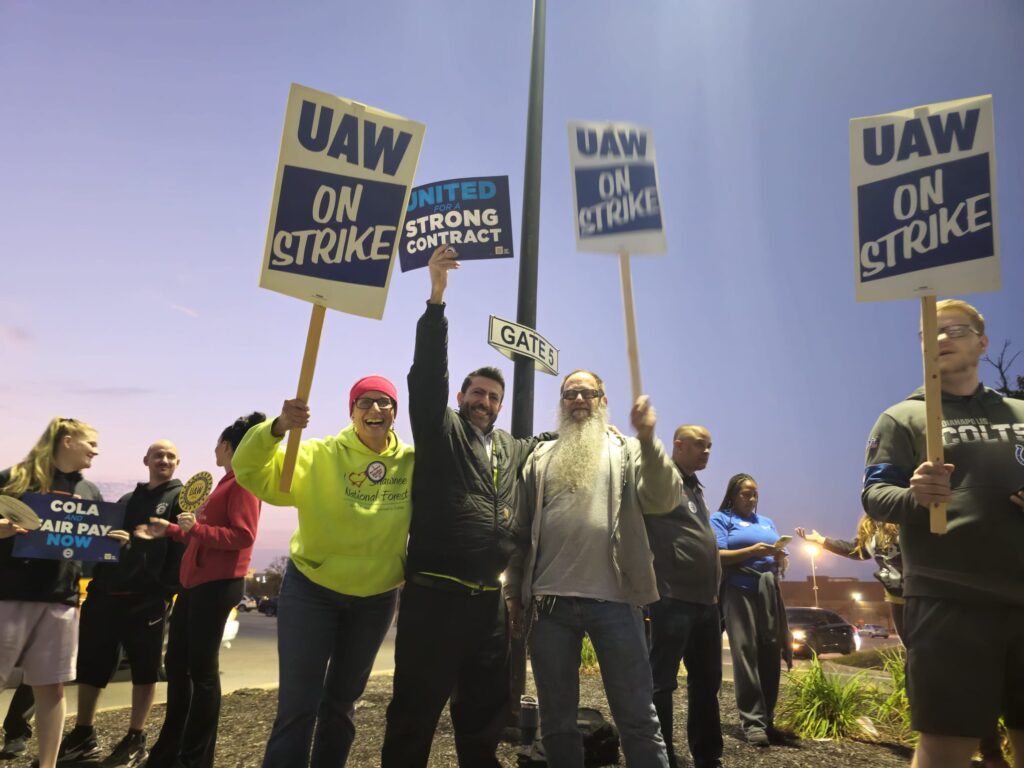Menu
Just Transition Insights, Issue #26, 01/29/2024
By Jonathan Tasini
|

[Editorial Note: Quick reminder for 2024: to bring our readers the most in-depth analysis and comprehensive information from around the globe curated by our small staff, we have moved to a monthly newsletter schedule. Please send us ideas and feedback!]
Leading Off: Auto Workers Just Transition Progress (Part 1)
While the United Auto Workers’ strike in the U.S. captured most of the attention, the UAW’s Canadian counterpart, UNIFOR, reached far-reaching Just Transition agreements with the same three companies (the UAW once represented Canadian autoworkers, and maintains close bargaining coordination with UNIFOR).
The Stellantis deal[1] has the following EV transition elements (“SUB” refers to “Supplemental Unemployment Benefit”):
Securing additional income security measures for the Electric Vehicle (EV) transition was another top priority for the bargaining committee. The following benefits will form the income security program for the Internal Combustion Engine (ICE) to EV Transition Blueprint:
- Employees who have completed one (1) year seniority and who exhaust their SUB credits during the retooling period will be eligible for Income Maintenance Benefits (IMP).
- Company will reimburse employees repayment of Employment Insurance benefits should annual net employment income from FCA Canada (Stellantis) sources exceed the annual maximum income threshold, as outlined by the Government of Canada (EI clawbacks).
- Company mandatory contributions to the DC pension plan (or CAAT DBplus plan if applicable) will continue during the retooling. Prorate the number of weeks required to qualify for full vacation in the year following retooling based on available months of production over the retool period.
- In addition to the job security commitments set out in Article 17.2 and related Skilled Trades job security provisions, Brampton and Windsor Assembly Plant will endeavour to retain all current Skilled Trades and apprentices at work during the retool periods.
- Special provisions will be effective during the retooling period up to a maximum of 24 months from date of layoff. Should the period extend beyond 24 months, the company and union will meet in advance to discuss extending this arrangement.
The UNIFOR agreements with General Motors[2] and Ford[3] were quite similar, with a laser focus on single locations, the St. Catharines Propulsion Plant and the Oakville Electric Vehicle Complex:
General Motors agreement key language:
Securing additional income security measures for the Electric Vehicle (EV) transition was another top priority for the bargaining committee. The following benefits will form the income security Transition Blueprint for the St. Catharines Propulsion Plant:
- The SUB benefit rate will be maintained at 70% during the retooling period.
- Employees with at least one (1) year seniority who exhaust their SUB credits during the retooling period will be eligible for the Income Maintenance Plan (IMP) benefit.
- Employment Insurance repayments (EI clawback) will be reimbursed by the company should annual net employment income exceed the annual maximum income threshold as outlined by the Government of Canada.
- Company contributions to the DC pension plan (or CAAT DBplus plan when applicable) will continue during the retooling.
- Vacation for 2025/2026 will be prorated based on available months of production in 2024/2025.
- These benefits are in place for 12 months of retooling. Should the retooling period extend beyond 12 months, the company and the union will meet in advance to discuss extending this arrangement.
Ford agreement key language:
Securing additional income security measures for the Electric Vehicle (EV) transition was another top priority for the bargaining committee. The following benefits will form the income security Transition Blueprint for the OEVC
ICE to EV transition during 2024.
- The SUB benefit rate will be maintained at 70% during the retooling period.
- Employees with at least one (1) year seniority who exhaust their SUB credits during the retooling period will be eligible for the Income Maintenance Benefit.
- Employment Insurance repayments will be reimbursed by the company should annual net employment income exceed the annual maximum income threshold as outlined by the Government of Canada.
- Company contributions to the DC pension plan (or CAAT DBplus plan if applicable) will continue during the retooling.
- Vacation for 2025/2026 will be prorated based on available months of production in 2024/2025.
- These benefits are in place for 8 months of retooling. Should the retooling period extend beyond 8 months the company and the union will meet in advance to discuss extending this arrangement.
Taken together, the three UNIFOR agreements are quite instructive about the need for collective bargaining to be the anchor for Just Transition.
[1]UNIFOR-STELLANTIS BARGAINING REPORT https://assets.nationbuilder.com/unifortheunion/pages/4020/attachments/original/1699044683/Unifor-Stellantis-Master_Report-final-web.pdf?1699044683
[2] UNIFOR-GENERAL MOTORS BARGAINING REPORT https://assets.nationbuilder.com/unifortheunion/pages/4004/attachments/original/1697232178/Unifor-GM-Master_Report-final-web.pdf?1697232178
[3] https://assets.nationbuilder.com/unifortheunion/pages/3945/attachments/original/1695494023/Unifor-Ford-Master_Report-final-revised.pdf?1695494023
SPONSOR MESSAGE
A message from the Australian Mining And Energy Union
We are fighting back, not just for ourselves but for the future generation of mineworkers. Workers deserve better. Our families and communities deserve better. Visit us
Spotlight: Auto Workers Just Transition Progress (Part 2)
Prior to the UAW’s strike, each of the Big Three—Ford, General Motors and Stellantis (Stellantis is the corporation formed from the merger of the Italian–American conglomerate Fiat Chrysler Automobiles and the French PSA Group)—had structured tie-ups for EV battery plants that, initially, were entirely non-union entities:
- Ultium Cells is a joint venture between GM and the South Korean LG Energy Solutions. The initial factory expansion at the partnership’s second battery cell factory located in Spring Hill, Tennessee called for a $275 million investment.
- Stellantis has announced two battery plant joint ventures with Samsung SDI—called StarPlus Energy—to be located in Kokomo, Indiana, with an announced investment in the two plants of $5.7 billion and the projected creation of 2,800 new jobs.
- Lastly, Ford had inked two joint venture deals with non-union entities—a deal with a Chinese battery manufacturer Contemporary Amperex Technology Co., or CATL; although the Marshall, Michigan plant is a wholly owned Ford subsidiary, Ford is licensing technology from CATL; and the project called BlueOvalSK Battery Park, a joint venture with SK Innovation.
The strike, and, thus, the role of collective bargaining, shifted the dynamic. We note in particular the progression of events at Ultium Cells. In December 2022, Ultium workers voted overwhelmingly for UAW representation, 710 to 16; the vote included all full-time and regular part-time production and maintenance employees who were employed through November 2022. In August 2023, the now-unionized workers voted overwhelmingly for a contract that raised wages $3 to $4 an hour, and also gave hundreds of workers thousands of dollars in back pay.
However, that still left Ultium workers at a pay scale, and benefits, far below autoworkers who were covered directly under the master contract at General Motors—a contract whose outlines were built over decades of negotiations. Projecting out to the future, the existence of two parallel contract standards in the electric vehicle industry would present a threat to future auto workers—if a joint venture was the locus of growth, and maintained a lower pay scale, it would almost assure, over time, a decline in the average pay for workers in the EV industry.
Thus, from a Just Transition standpoint, perhaps the most significant advance occurred when General Motors agreed, at a point when the strike was still in full swing, to bring the Ultium workforce under the master contract.
Ideas: Job Creation Standards Would Help
It has always been a challenge throughout the globe to set minimum standards for jobs. The competition for jobs by communities can be fierce, setting one community against another.
We thought, in light of the discussion around standards to be implemented in electric vehicles, we’d share a tool promoted by Jobs to Move America, a non-profit policy and organizing center: the U.S. Employment Plan embeds high quality in any bids for publicly-financed projects. It has three basic pieces (the emphasis in bold has been added):
-
Proposal tool: language that can give transportation equipment manufacturers the opportunity to earn extra credit in the bidding process by proposing the creation and/or retention of a proposed number and quality of U.S. jobs supported in connection to a contract, facilities, and commitments to hiring workers facing multiple and significant barriers through recruiting and training efforts.
-
Evaluation tool: provides a system of voluntary price credits and/or a scoring method to help public agencies to evaluate the quality of proposals submitted in response to a request for procurements.
-
Compliance & implementation tool: contract and enforcement language that ensures transparency and accountability for U.S. jobs, hiring and training commitments on a contract.
It seems clear that tools like this one would go a long way to ensuring high quality jobs, at least in public projects, and, thus, advance the idea of “high bar” Just Transition since workers would know they were going into a new, more secure, quality job with clear information about wages to be paid.

Opinion: COP28—An Assessment
By Jan Philipp Rohde
There were intensive discussions on climate adaptation measures, climate mitigation measures, financing for climate damages (“Loss & Damage”), and the Just Transition Work Programme.
Departure from fossil fuels and the use of alternative technologies
The international community committed to a ” transitioning away from fossil fuels in energy systems, in a just, orderly and equitable manner”. More than 100 countries (including Germany) had previously demanded a clear commitment to phasing out fossil fuels. Although many stakeholders might have wanted more, this compromise can be considered a historic success and a clear signal for a global energy transition.
Especially, the debate on the “how” of climate protection is now fuelled. According to the closing statement, climate neutrality should be achieved by 2050, with technology playing a significant role. Carbon capture and storage, as well as nuclear power, are among the technologies aimed at achieving climate neutrality by 2050.
Fund for compensating climate change impacts
The conference began with a breakthrough in the fund for compensating the impacts of climate change. Early in the negotiations, several countries agreed to provide financial resources to compensate for damages caused by climate change. A minimum share is reserved for the poorest countries and small island states. The next steps involve clarifying specific details and ensuring long-term funding. Unions have supported the establishment of this fund and advocate for its long-term financing.
Climate adaptation
Climate adaptation is gaining increasing attention with advancing climate change. Besides the increasingly severe disasters, discussions focused on anticipated migration movements. For the first time, the closing statement documented the enormous financial needs for climate adaptation. The next steps involve developing and adopting a framework for climate adaptation with measurable goals and indicators. Unions also advocate for a stronger consideration of occupational safety, as well as adequate financial and personnel resources for disaster management, healthcare, and other public service institutions.
Just Transition Work Programme (JTWP)
The JTWP was launched at the last climate conference in Egypt. Its goal is to describe concrete ways to achieve the Paris Climate goals with a focus on justice and decent work. It has been a significant success for unions in recent years to establish the term “Just Transition.” Many actors now label their activities under this term. In addition to environmental organizations, more and more companies use the term to secure profits with this narrative.
The union delegation has a clear position, reflected in the Paris Climate Agreement and the formulations of ILO guidelines on “Just Transition.” The goal is a close examination with a focus on good work, the impact of transformation on the labor market, and a just shape of structural change in the interest of employees. The closing statement partially addresses this and emphasizes that structural change should be shaped under the conditions of good jobs, social dialogue, social security, and labor and human rights.
The next step will involve establishing concrete agreements for a “Just Transition.”
What’s next?
The issues of climate adaptation, climate protection, and climate financing will continue in 2024. A central focus next year will be on revising national climate contributions (NDCs), which must be updated and submitted by 2025.
From the union’s perspective, it will be essential to integrate not only pure target commitments to avoid greenhouse gases but also employment- and distribution-oriented aspects into the goal matrix. These could include figures on the impact on the labor market, requirements for good work, questions of distribution justice, or regional economic implications. As the Climate Framework Convention sets the framework for European and national climate policies, the process is of high importance for trade unions.”
Rohde is a senior officer for environmental, climate and sustainability policy for the German Trade Union Confederation (DGB)
Links
Stand Up Tesla: a site for Tesla workers to sign an Authorization Card to join the UAW.
Table of Contents
Leading Off
COP 28—Pointless
Spotlight
Tesla Attacks The Swedish Model
Ideas
An Alternative To COP
Opinion
Why The Renewable Energy Industry Needs Unionizing
Links
This Week's Links
Can’t wait to subscribe to the newsletter?
*We post information pursuant to the U.S. Fair Use Doctrine, and applicable international standards, in order to advance the knowledge base and education of our global audience. We endeavor to include the original link to documents. However, upon requests of original authors of posted documents, where explicit use permission is not granted, we will remove documents if it is determined continued use is not appropriate. We also reserve the full right to not include, or remove, any data inconsistent with our mission.
















